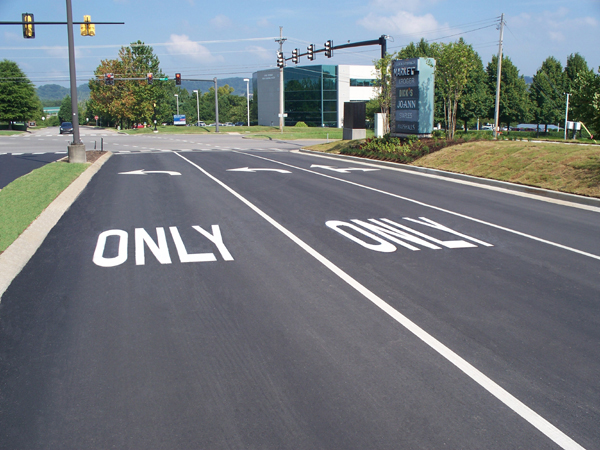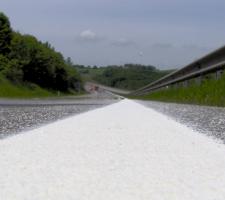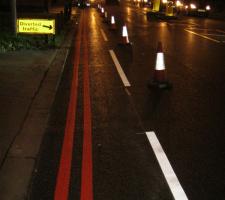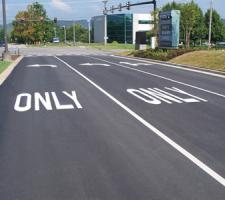
A new SWARCO Industries facility will produce preformed thermoplastic used for intersection markings and specialty markings
Road markings as a simple yet extremely effective method of guiding motorists safely on the world's road. Patrick Smith reports
Road markings are as important as road signs and give information about the roads being travelled on and actions that drivers should or should not be taking. For example, in many instances white lines often tell motorists something about the road: longitudinal lines can warn of situations that require action such as turn right, left or do not cross. Transverse lines often mean give-way or stop.There are many variations on these lines such as broken lines, double lines and the colours may vary, but they are all there to guide and warn.
In the United States,
"The product offering will initially include white and yellow colours in 3ft (91.5cm) flat sections in 90mm and 125mm thicknesses, with plans to develop the product offering to include specialty colours including blue, red, green and orange along with custom designs and logos," explains SWARCO Industries' general manager Jon Sproul.
The new product development has been ongoing over the last two years based on SWARCO's 25 years' of thermoplastic marking compound formulating experience.
The product will utilise premium SWARCO glass bead technology and application techniques to provide "superior reflective properties and performance." Meanwhile, cost efficient cold spray plastic lines with wet retroreflectivity and durability are claimed by
The product is a cost-efficient cold spray plastic line with wet retroreflectivity and durability for medium trafficked roads ranging from 5,000-20,000 vehicles/day.
Field tests on A8 between Munich, Germany, and Salzburg, Austria, shows RL values [night visibility] between 130 and 230 depending on where the lines are placed on the road and the geometry of the road.
"The results are shown even after three years on a road with snowploughs running frequently over the markings," says Geveko.
"InjectLine is an economic and easy solution for improving spray markings. By combining PlastiRoute cold spray plastic, coarse intermix material (glass beads and anti-skid material), fine UCme drop-on material and machinery you get agglomerate-like structured Type II road markings in layer thickness of 0.75-1.5mm by using film thicknesses as low as 0.4mm." Geveko says that InjectLine is a thin layer marking with values equivalent to thick layer markings, but are efficient in comparison to conventional Type II markings in terms of economic material usage and high laying coverage.
The mixture of glass beads and anti-skid material injected into the sprayed line secures the long term retroreflection and skid resistance.
Small and well embeddable glass beads are sufficient for good retroreflection values, (as proved by P7
The Swedish group has also been highlighting recent contracts including those in Norway, where it says it has received several contracts covering four years, and in Denmark it has won major contracts for Southern Jutland, while in Sweden it has received a two-year contract for the Västernorrland and Dalarna regions with an option for another two years.
Geveko's Romanian subsidiary has contracts in five regions (procurement is divided into eight regions), which have been renewed for 2011 with increased volumes, and the subsidiary of Geveko's Turkish associate company has obtained a road marking contract in Turkmenistan, which includes some 180tonnes of Geveko's thermoplastic ViaTherm.
"Negotiations are ongoing on the selection of more roads amounting to a volume of about 300tonnes," says Geveko.
Long life and high visibility are claimed for
They can be applied to old or new road surfaces or over existing markings, and can be laid either by hand or by using a 3M manual or automatic tape applicator.
All the Stamark tapes provide high reflectivity in daylight, dusk and the dark, and there are three tapes currently available for permanent application. Series A380ESD is a permanent road marking tape that uses 3M high index ceramic beads, providing reflectivity, particularly on dark, wet nights, while Series A650ESD (white) and A651ESD (yellow) "provide excellent road presence, reflectivity and the ability to install without the need for specialist equipment." The Stamark A710SD provides high levels of both wet (even when fully submerged) and dry reflectivity.
In Ireland, the country's largest motorway, the M3, features 30,000 3M 301/290 Marker Series road studs from 3M, and this follows an earlier project which saw 9,000 of its Marker Series 290 road studs chosen for a 24km stretch of brand new motorway that connects Dublin and Waterford.
In another development,
"The innovative design means Paintmark is applied by hand or hand roller without the need for any heat. It is trafficable immediately and actually strengthens its bond with the road surface as traffic passes over it, and can therefore be used for short or long-term projects," says Ennis Prismo.
"Paintmark is unlike traditional markings such as thermoplastic and paint that require aggressive removal processes which damage the road surface. The removal method for Paintmark requires no hydroblasting or scabbling. It is clean, quick and simple, causing no damage or scarring to the road." The product is simply heated and peeled up, cleaning the area in the process.
Paintmark combines High Build, said to be a proven, durable, waterborne road paint, with a natural bitumen adhesive.
The specialised manufacturing process means that a wide range of designs and colours can be produced, ranging from simple items such as standard lines and arrows to more complex symbols and even logos.
"The product can also be reflectorised with the addition of glass beads in the manufacturing process.
"Additional benefits include flexibility even at low temperatures making Paintmark easy to work with, and environmentally friendly manufacturing and installation processes."

















